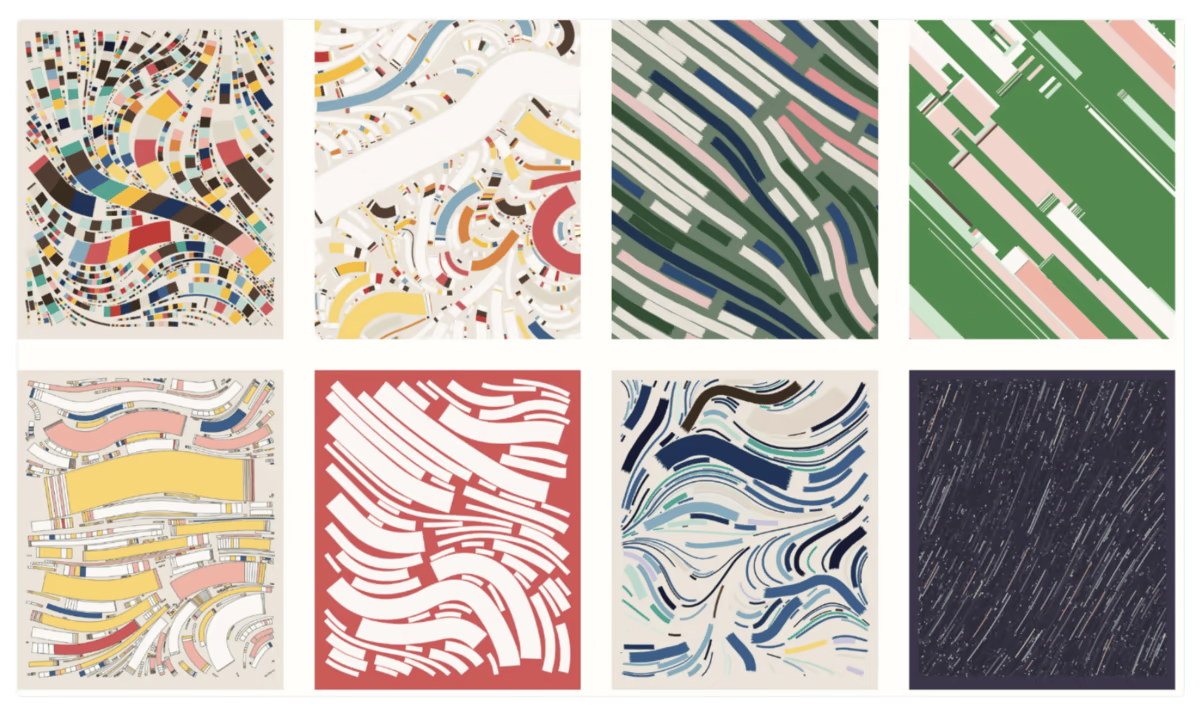Exploring the Techniques Behind Generative Art
Generative art is a captivating intersection of art, technology, and nature, driven by algorithms and creative processes. One of my goals in this journey was to understand the key techniques that define generative art. After analyzing various sources and exploring the works of influential artists, I identified recurring characteristics and techniques that form its foundation.
Core Characteristics of Generative Art
Randomness
Randomness introduces unique variations into each piece, ensuring every outcome feels fresh and unexpected. This element often brings surprise and organic quality to the work.
- Where can it be used?
Procedural Landscape Generation, Typographic Distortions, Particle Systems, Pattern Generation
Iteration
Iteration involves repeating a set of rules or actions in cycles, allowing each step to build upon the last. This process creates intricate, evolving patterns.
- Where can it be used?
Recursive Growth, Grid Subdivision, Wave Animations, Layered Textures
Emergence
Emergence arises from simple rules interacting in complex ways, producing organic, sophisticated patterns that feel alive.
- Where can it be used?
Swarm Simulations, Dynamic Grids, Interactive Systems
Mathematics
Mathematics provides structure and logic to generative art, blending harmony and creativity. Functions like fractals, sine waves, or parametric equations are often used.
- Where can it be used?
Spiral Patterns, Symmetry Creation, Noise-Based Textures, Parametric Design
Natural Systems
Drawing inspiration from nature, generative art replicates processes like growth, randomness, and self-organization to create lifelike designs.
- Where can it be used?
Simulating Growth, Erosion Simulation, Fluid Dynamics, Biomimicry in Design
Summary of Generative Art Techniques
-
Random Walks
Inspired by Manfred Mohr, random walks create unpredictable, organic patterns with endless possibilities. -
Random & Perlin Noise
- Random Noise: Raw, unpredictable variations.
- Perlin Noise: Smooth randomness for natural textures.
-
Circle Packing
Expanding circles placed without overlap, combining randomness with structure. -
Fibonacci Patterns
Forms inspired by the golden ratio, producing elegant, nature-like designs. -
L-Systems
Rule-based branching structures, creating complex designs from simple rules. -
Grids
Provide order and structure for intricate compositions. -
Tiling
Geometric variations inspired by tessellations, like Truchet tiles. -
Flow Fields
Lines or shapes move fluidly across grids, guided by set rules. -
Reynolds Steering
Simulates natural group behavior, like bird flocks or fish schools, for dynamic visuals.
Conclusion
Generative art uses randomness, repetition, and math, along with ideas from nature and technology. Learning about these techniques showed me how simple rules mixed with creativity can create amazing and detailed designs. Methods like circle packing and flow fields show how structure and unpredictability work together. Exploring these techniques helped me understand generative art better and gave me new ideas to try in my own work.
After exploring various examples, I found Fidenza by Tyler Hobbs particularly inspiring. It’s fascinating how the artist combined different techniques to create such captivating visuals. The artist uses randomness to make each piece unique, iteration to add layers and depth, and emergence to create patterns that look natural and interesting.
 Image from Tyler Hobbs Website - Source
Image from Tyler Hobbs Website - Source
I get inspired every day by artists I follow on social media. I love seeing how they take simple ideas and turn them into creative projects using code. It’s exciting to watch them improve their skills and come up with even more interesting work.
- Mike Van Sanden- Website
- Andreion de Castro- Instagram
- Kevin Koch- Instagram
- Talia Cotton- Instagram
Sources
- Mansion, M. (2023b, August 9). On Algorithmic art - creative Pinellas. Creative Pinellas. https://creativepinellas.org/magazine/algorithmic-art/
- Zafeiriou, S. (2024, December 12). Generative Art for Beginners: 10 Essential Techniques | Steve Zafeiriou. Steve Zafeiriou. https://stevezafeiriou.com/generative-art-for-beginners/
- Goodchild, A. (2024, May 22). What is Generative Art? — Amy Goodchild. Amy Goodchild. https://www.amygoodchild.com/blog/what-is-generative-art